
The food pyramid shows what to eat less of and what to eat more of.
However, many of us do not eat a balanced diet according to the recommended guidelines, as an Estonian study on eating behavior shows. No wonder people do not get enough nutrients.
Two pyramids can be compared here.
One shows the recommended proportions of volumes that ensure a balanced diet, while the other shows the actual diet of the average Estonian.
To eat a balanced and varied diet, you should eat according to the food pyramid recommended above. The recommended pyramid shows the approximate amount of food that should be eaten in a week to meet nutritional needs. There are five major food groups in the pyramid, each of which should have something to eat on a daily basis. At the top of the pyramid are sweets and salty foods, which the body does not need for its functioning and should be consumed rarely and in small amounts.
There is a lot of contradictory information about healthy eating in the media. You just have to stay on the sidelines and remember that there are no superfoods, genius nutrition programs or magic remedies that are effective for long-term health or weight loss.
The body needs to obtain from food both enough energy to function and all the nutrients it needs. An unbalanced and monotonous diet leads to nutritional deficiencies, which affect the body in many ways and can cause serious diseases.
One of the consequences of an unbalanced diet is weight problems: if the body does not get enough nutrients from food, it forces us to eat more.